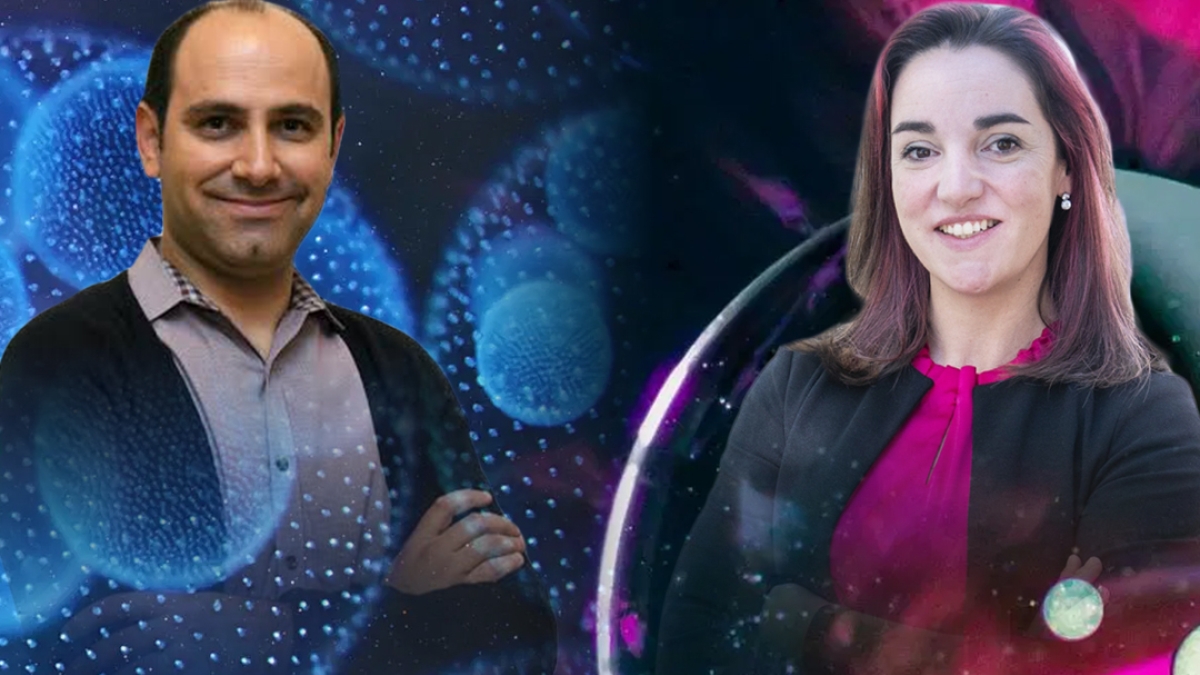Advancing super materials: 2 ASU professors honored as Navrotsky Professors of Materials Research

ASU scientists Seth Ariel Tongay (left), a professor in ASU’s School for Engineering of Matter, Transport and Energy, and Christina Birkel, an associate professor in ASU’s School of Molecular Sciences, have been appointed as Navrotsky Professors of Materials Research. Courtesy photos
Imagine a material as tough as steel but as flexible as rubber, and another that can conduct electricity and respond to light in remarkable ways.
Two Arizona State University scientists, Christina Birkel, an associate professor in ASU’s School of Molecular Sciences, and Seth Ariel Tongay, a professor in ASU’s School for Engineering of Matter, Transport and Energy, are pioneering the discovery of such innovative materials to create the technologies of the future. In recognition of their work, both have been appointed as Navrotsky Professors of Materials Research.
The Navrotsky Professorship provides the opportunity for outstanding faculty to not only innovate in their research with financial support but also grow in their careers. Faculty are selected for the prestigious two-year professorship based on their significant contributions in the broadly defined field of materials research.
“Christina has a worldwide reputation in solid-state chemistry and active research both at ASU and in Darmstadt, Germany, and Seth has a global reputation in semiconductor research,” said Alexandra Navrotsky, herself a solid-state chemist, Regents Professor in ASU’s School of Molecular Sciences and director of the Navrotsky Eyring Center for Materials of the Universe.
The professorship aims to empower faculty to take on leadership roles, fostering innovation in materials research and promoting collaborations across the Department of Physics, the School of Molecular Sciences, the School for Engineering of Matter, Transport and Energy, and the School of Earth and Space Exploration.
"The Center for Materials of the Universe brings together some of the brightest minds in materials research,” said Ferran Garcia-Pichel, ASU’s interim dean of natural sciences at The College of Liberal Arts and Sciences. “The Navrotsky Professorships will enable these professors to explore and expand upon important research topics. I am excited to see what Professor Tongay and Associate Professor Birkel are able to accomplish and work on over these next two years."
Christina Birkel
Birkel’s research focuses on the preparation and characterization of new types of materials — in particular, carbides, nitrides and carbonitrides, which are special combinations of carbon, nitrogen and metals, with varying chemical composition and morphology.
She and her lab specialize in synthesis and structural analysis, striving to understand connections between how these materials are made and their structure, microstructure and surface properties.
“I am excited about the opportunity to optimize and accessorize an instrument that enables us to study chemical reactions while they happen (in situ) under conventional and nonconventional (microwave) heating conditions,” Birkel said. “This system will deliver crucial insights into how solids form and guide our efforts in making new types of materials with targeted functionalities.”
Birkel continued, “I am deeply honored to be appointed as a Navrotsky Professor of Materials Research. Professor Navrotsky is a true inspiration for me because she not only embodies high-impact science and pushes the boundaries of what we know, but she is also an active and respected member of the materials research community who gives back to this community to enable her fellow scientists to thrive.”
Seth Ariel Tongay
Tongay’s research focuses on the manufacturing of semiconductors and synthesis, and fundamental understanding of low-dimensional materials. His team uses state-of-the-art manufacturing and characterization techniques to enable next-generation applications, such as quantum information, energy conversion (catalysis and photovoltaics) and chemical engineering (desalination, purification and gas separation).
Employing diamond anvil cell high-pressure technology in conjunction with low-temperature spectroscopy techniques, Tongay explores fundamental questions within the realms of quantum and two-dimensional (2D) materials. Through the application of high hydrostatic or uniaxial pressure, he generates entirely novel phases in 2D and quantum material systems, unraveling new quantum functionalities that find utility in the domain of quantum optical communication.
More University news

3 ASU students earn Goldwater Scholarships for STEM research excellence
Three Arizona State University students have been named Goldwater Scholars for 2025, placing them among the nation’s most promising undergraduates pursuing research careers in science, engineering…

Provost Teaching Awardees, Charter Professors empower local communities, students
The ASU Charter embodies the university’s commitment to student success and research of public value and responsibility to the community. In recognition of its importance, each year, Executive…

New online Bachelor of Social Work program exceeding enrollment expectations
Social workers are in big demand.Citing U.S. Bureau of Labor Statistics figures, the National Association of Social Workers projected the profession will grow 7% by 2033, faster than the average for…

